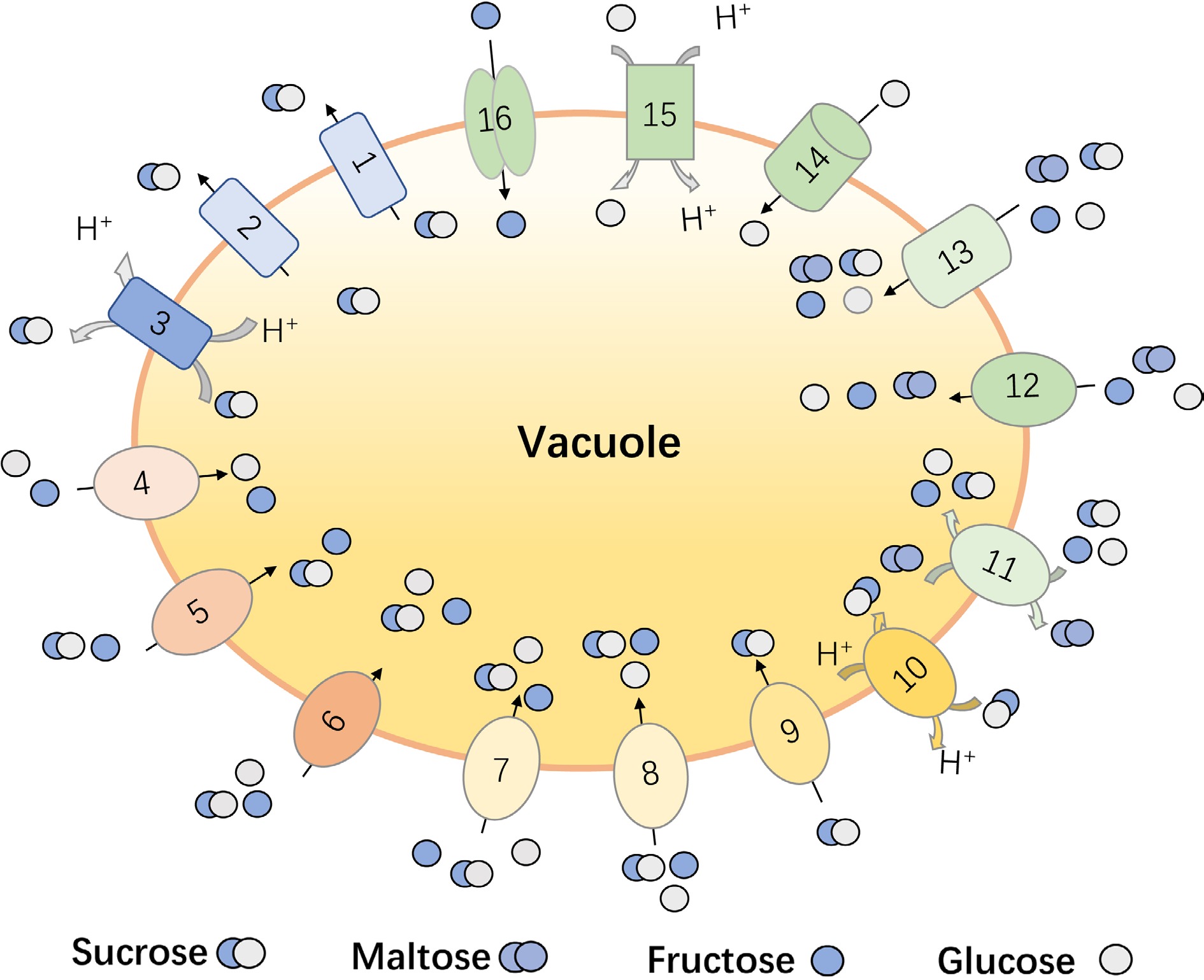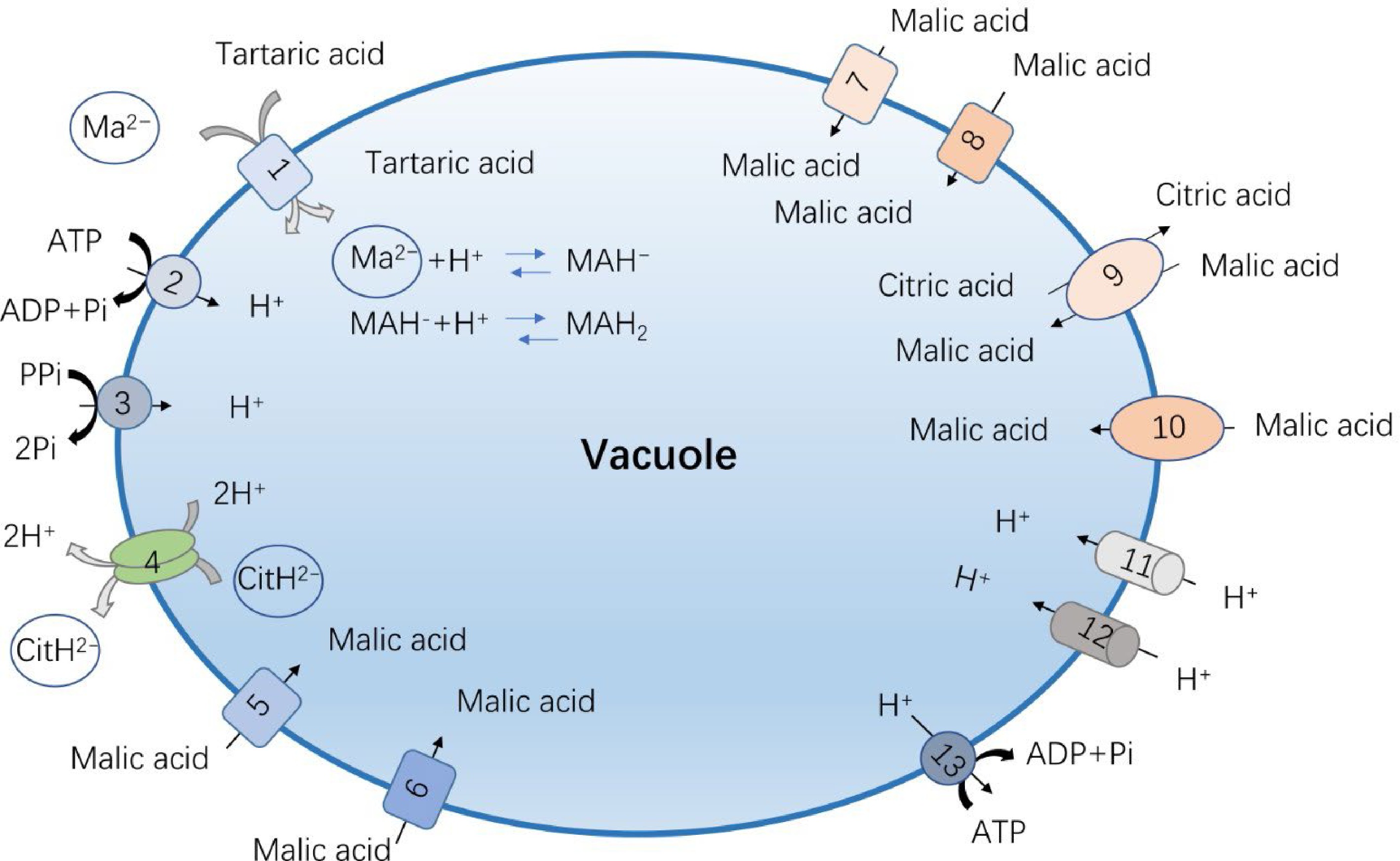-

Figure 1.
The reported vacuolar sugar transporters in fruit crops. (1) Malus domestica sucrose transporters, MdSUT4; (2) Citrus sinensis sucrose transporters, CsSUT4; (3) Beta vulgaris sucrose transporters, BvSUT1; (4) Vitis vinifera tonoplast sugar transporter, VvTMT1 and VvTMT2; (5) Malus domestica tonoplast sugar transporter, MdTMT1 and MdTMT2; (6) Cucumis melo tonoplast sugar transporter, CmTST1 and CmTST2; (7) Pyrus bretschneideri tonoplast sugar transporter, PbTMT4; (8) Citrullus lanatus tonoplast sugar transporter, ClTST2; (9) Beta vulgaris tonoplast sugar transporter, BvTST2.1; (10) Solanum tuberosum tonoplast sugar transporter, StTST3.1; (11) Solanum tuberosum tonoplast sugar transporter, StTST3.2; (12) Prunus persica tonoplast sugar transporter, PpTST1; (13) Fragaria vesca tonoplast sugar transporter, FvTST1; (14) Malus domestica vacuolar glucose transporter, MdVGT1. (15) Malus domestica early response to dehydration-like 6, MdERDL6-1; (16) Citrus sinensis sugars will eventually be exported transporter, CsSWEET16.
-

Figure 2.
The reported vacuolar acid transporters and proton pumps in fruit crops. (1) Vitis vinifera aluminum-activated malate channel protein, VvALMT9; (2) Malus domestica V-ATPase (vacuolar H+-ATPase, abbreviated VHA), MdVHA-A; (3) Malus domestica V-PPase (vacuolar H+-pyrophosphatase, abbreviated VHP), MdVHP1; (4) Citrus sinensis citrate transporter 1, CsCit1; (5) Malus domestica aluminum-activated malate channel protein, MdALMT9; (6) Ziziphus jujuba aluminum-activated malate channel protein, ZjALMT4;(7) Solanum lycopersicum aluminum-activated malate channel protein, SlALMT5;(8) Solanum lycopersicum aluminum-activated malate channel protein, SlALMT9; (9) Solanum lycopersicum tonoplast dicarboxylic transporter, SlTDT1; (10) Malus domestica tonoplast dicarboxylic transporter, MdTDT1; (11) Malus domestica P-type ATPases, MdPH1 and MdPH5; (12) Citrus sinensis P-type ATPases, CsPH1 and CsPH5; (13) Citrus sinensis V-ATPase (vacuolar H+-ATPase, abbreviated VHA), MdVHA-A.
-
Proteins Species Functions Reference VvALMT9 Vitis vinifera L.(grape) Unidirectional transport of malic acid and tartaric acid to vacuoles. [56] MdALMT9 Malus domestica Borkh. (apple) WRKY31-ERF72-MA1 network regulates malic acid accumulation in apple fruit. [84] Ma1 Malus domestica (apple) ma1 reduces its malic acid transport function by removing the conservative C-terminal domain of MA1, resulting in low acidity of apple fruit. [59][54] ZjALMT4 Ziziphus jujuba Mill.(jujube) ZjWRKY7 activates the expression of ZjALMT4 to promote the accumulation of malate. [85] SlALMT5 Solanum lycopersicum (tomato) The SLALMT5 transported malate and inorganic anions such as nitrate and chloride, but not citrate. [56] SlALMT9 Solanum lycopersicum (tomato) SlALMT9 can determine the malic acid content and aluminum tolerance of tomato. [57] SlTDT Solanum lycopersicum (tomato) The overexpression of SlTDT significantly increased the content of malic acid in tomato fruit and decreased the content of citric acid. [50] MdTDT1 Malus domestica Borkh. (apple) MdMYB1 can affect the expression of acid transporters Ma1 and MdtDT to regulate fruit acidity. [86] CsCit1 Citrus sinensis. cv Washington CsCit1mediates CitH2- and CitH2--dependent H+ efflux from the vacuole and maintains vacuolar acidic pH and citric acid homeostasis. [62] DsSWEET17 Dianthus spiculifolius (caryophyllus) Influence on sugar metabolism and tolerance to stress in Arabidopsis thaliana. [87] MdSUT4 Malus domestica (apple) MdSUT4 may participate in the efflux of sucrose from the vacuolar membrane and may promote the synthesis of flavonoids. [28] CsSUT4 Citrus sinensis (citrus) In the natural state, CsSUT4 mainly mediates the output of sucrose in vacuoles. [29] BvSUT1 Beta vulgaris L.(sugar beet) BvSUT1 is a sucrose transport protein responsible for transporting sucrose to the main root of sugar beet. [26] VvTMT1 Vitis vinifera L.(grape) VvTMT1 participates in vacuolar monosaccharide transport and plays a major role in stress response. [88] VvTMT2 Vitis vinifera L.(grape) VvTMT2 gene is involved in the transport of hexose from cytoplasm to vacuole during berry ripening and over-ripening. [89] MdTMT1 and MdTMT2 Malus domestica Borkh. (apple) MdTMT1 and MdTMT2 are involved in the accumulation of fructose and sucrose during apple fruit ripening. [90] CmTST2 Cucumis melo L.(melon) CmTST2 plays an important role in sugar accumulation of melon fruit. [38] CmTST1 Cucumis melo L.(melon) CmTST1 transports sugar into vacuoles. [33] PbTMT4 Pyrus bretschneideri (pear) PbTMT4 participates in the sugar accumulation of vacuoles, thus affecting the growth and development of plants. [35] ClTST2 Citrullus lanatus (watermelon) ClTST2 encodes a vacuolar membrane protein, and its expression is related to the uptake and accumulation of vacuolar membrane sugar in watermelon pulp cells. [37] BvTST2.1 Beta vulgaris L.(sugar beet) The transporter BvTST2.1 is responsible for the uptake of vacuole sucrose in beet taproots. [40] PpTST1 Prunus persica L. (peach) Overexpression of PpTST1 led to a decrease in organic acid content and an increase in sugar content in peach and tomato fruits, indicating that it has dual functions in sugar accumulation and organic acid content. [39,91] StTST3.1 Solanum tuberosum L. (potato) StTST3.1-silenced leaves accumulated exceptionally high levels of maltose but low levels of sucrose and hexose. [92] StTST3.2 Solanum tuberosum L. (potato) Silencing of StTST3.2 in potato by stable transformation resulted in significantly lower RS content in tubers at harvest or after room temperature storage. [93] FvTST1 Fragaria vesca L. (strawberry) FvTST1 can mediate the uptake of different sugars, such as fructose, glucose, sucrose, and mannose. [94] MdVGT1 Malus domestica Borkh. (apple) MdVGT1 and MdTMT1 interact to transport glucose into vacuole. [95] MdERDL6-1 Malus domestica Borkh. (apple) MdERDL6-1 is a vacuole membrane H+/glucose co-transporter. [31] CsERD6L Citrus sinensis (citrus) The function of CsERD6L was verified to have glucose transport activity. [29] LeVHA-AP1 Lycopersicon esculentum L. (tomato) The concentration of sucrose in fruit of antisense transgenic tomato with V-ATPase A subunit was increased, but the concentration of glucose and fructose did not change. [71] MdVHA-A Malus domestica Borkh. (apple) MdVHA-A was involved in malate accumulation and vacuolar acidification in apple. [70] CitVHA-c4 C. reticulata Blanco cv. Ponkan CitVHA-c4 was reported to be involved in citric acid accumulation. [68] MdVHP1 Malus domestica Borkh. (apple) Overexpression or heterologous expression of V-PPase coding gene MdVHP1 significantly promoted the accumulation of malic acid in apple callus and tomato fruit. [96] MdPH1 and MdPH5 Malus domestica Borkh. (apple) MdPH1 and MdPH5 have been identified and shown to be involved in vacuolaracidification and malate accumulation [70] CitPH1 and CitPH5 Citrus sinensis. Cv Washington CitPH1 and CitPH5, are expressed in the fruits of sour lemon, orange, pummelo, and rangpur lime. [77] Ma10 Malus domestica (apple) Ma10 gene encodes P3A H+- ATPase of the vacuolar membrane that controls the vacuolar acidification of apple fruit. [55] Table 1.
The reported vacuolar membrane proteins involved in sugar and acid accumulation in fruit crops.
Figures
(2)
Tables
(1)